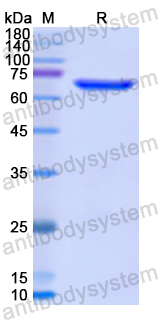Catalog No.
YHF07801
Expression system
E. coli
Species
Homo sapiens (Human)
Protein length
Met1-Lys377
Predicted molecular weight
67.58 kDa
Nature
Recombinant
Endotoxin level
Please contact with the lab for this information.
Purity
>90% as determined by SDS-PAGE.
Accession
P55036
Applications
ELISA, Immunogen, SDS-PAGE, WB, Bioactivity testing in progress
Form
Lyophilized
Storage buffer
Lyophilized from a solution in PBS pH 7.4, 0.02% NLS, 1mM EDTA, 4% Trehalose, 1% Mannitol.
Reconstitution
Reconstitute in sterile water for a stock solution. A copy of datasheet will be provided with the products, please refer to it for details.
Shipping
In general, proteins are provided as lyophilized powder/frozen liquid. They are shipped out with dry ice/blue ice unless customers require otherwise.
Stability and Storage
Use a manual defrost freezer and avoid repeated freeze thaw cycles. Store at 2 to 8°C for frequent use. Store at -20 to -80°C for twelve months from the date of receipt.
Alternative Names
26S proteasome regulatory subunit S5A, MCB1, 26S proteasome regulatory subunit RPN10, ASF, Multiubiquitin chain-binding protein, PSMD4, 26S proteasome non-ATPase regulatory subunit 4, AF, Antisecretory factor 1
Patient-centered brain transcriptomic and multimodal imaging determinants of clinical progression, physical activity, and treatment needs in Parkinson's disease., PMID:39952947
Rational strategies for designing next-generation oncolytic viruses based on transcriptome analysis of tumor cells infected with oncolytic herpes simplex virus-1., PMID:39850819
Proteomic Profiling of Potential E6AP Substrates via Ubiquitin-based Photo-Crosslinking Assisted Affinity Enrichment., PMID:39797819
Screening, identification and functional validation of Microcystin-LR direct binding target proteins based on thermal proteomics profiling., PMID:39675292
DNA damage-induced proteasome phosphorylation controls substrate recognition and facilitates DNA repair., PMID:39172782
The impact of dietary Laminaria digitata and alginate lyase supplementation on the weaned piglet liver: A comprehensive proteomics and metabolomics approach., PMID:38151157
Application of OpenArray Technology to Assess Changes in the Expression of Functionally Significant Genes in the Substantia Nigra of Mice in a Model of Parkinson's Disease., PMID:38137024
Identification of PSMB4 and PSMD4 as novel target genes correlated with 1q21 amplification in patients with smoldering myeloma and multiple myeloma., PMID:37608776
A novel endoplasmic reticulum adaptation is critical for the long-lived Caenorhabditis elegans rpn-10 proteasomal mutant., PMID:37355092
PSMD8 can serve as potential biomarker and therapeutic target of the PSMD family in ovarian cancer: based on bioinformatics analysis and in vitro validation., PMID:37349676
PSMD4 drives progression of hepatocellular carcinoma via Akt/COX2 pathway and p53 inhibition., PMID:37336868
TMT-Based Comparative Proteomic Analysis of the Spermatozoa of Buck (Capra hircus) and Ram (Ovis aries)., PMID:37239333
Bisphenol-A (BPA) Impairs Hippocampal Neurogenesis via Inhibiting Regulation of the Ubiquitin Proteasomal System., PMID:36828952
E6AP AZUL interaction with UBQLN1/2 in cells, condensates, and an AlphaFold-NMR integrated structure., PMID:36827983
Machine Learning Selection of Most Predictive Brain Proteins Suggests Role of Sugar Metabolism in Alzheimer's Disease., PMID:36776048
Ubiquitin receptor PSMD4/Rpn10 is a novel therapeutic target in multiple myeloma., PMID:36630605
FAT4 activation inhibits epithelial-mesenchymal transition (EMT) by promoting autophagy in H2228/Cer cells., PMID:36576661
Trans-ancestry, Bayesian meta-analysis discovers 20 novel risk loci for inflammatory bowel disease in an African American, East Asian and European cohort., PMID:36308435
Ubiquitin receptors play redundant roles in the proteasomal degradation of the p53 repressor MDM2., PMID:35735670
Integrative Analysis of Nanopore and Illumina Sequencing Reveals Alternative Splicing Complexity in Pig Longissimus Dorsi Muscle., PMID:35480309
The Prognostic Significance of Proteasome 26S Subunit, Non-ATPase (PSMD) Genes for Bladder Urothelial Carcinoma Patients., PMID:34992336
Hsp90-associated DNA replication checkpoint protein and proteasome-subunit components are involved in the age-related macular degeneration., PMID:34629418
Upregulation of Rpn10 promotes tumor progression via activation of the NF-κB pathway in clear cell renal cell carcinoma., PMID:34133712
Atractylenolide I enhances responsiveness to immune checkpoint blockade therapy by activating tumor antigen presentation., PMID:33830945
Quantitative expression of Ikaros, IRF4, and PSMD10 proteins predicts survival in VRD-treated patients with multiple myeloma., PMID:33284947
Upregulation of PSMD4 gene by hypoxia in prostate cancer cells., PMID:33110365
In vitro and ex vivo gene expression profiling reveals differential kinetic response of HSPs and UPR genes is associated with PI resistance in multiple myeloma., PMID:32724061
Unstructured Biology of Proteins from Ubiquitin-Proteasome System: Roles in Cancer and Neurodegenerative Diseases., PMID:32455657
[Qualitative difference of mitochondrial subproteoms of brain RPN10- and RPN13-binding proteins]., PMID:32420894
Structure of E3 ligase E6AP with a proteasome-binding site provided by substrate receptor hRpn10., PMID:32157086
Inactive USP14 and inactive UCHL5 cause accumulation of distinct ubiquitinated proteins in mammalian cells., PMID:31703099
Ubiquitin receptors are required for substrate-mediated activation of the proteasome's unfolding ability., PMID:31601863
Loss of nuclear UBE3A causes electrophysiological and behavioral deficits in mice and is associated with Angelman syndrome., PMID:31235931
PSMD4 regulates the malignancy of esophageal cancer cells by suppressing endoplasmic reticulum stress., PMID:31162820
ATG8-Binding UIM Proteins Define a New Class of Autophagy Adaptors and Receptors., PMID:30955882
Inhibition of PSMD4 blocks the tumorigenesis of hepatocellular carcinoma., PMID:30930224
Rpn10 promotes tumor progression by regulating hypoxia-inducible factor 1 alpha through the PTEN/Akt signaling pathway in hepatocellular carcinoma., PMID:30673593
Structure of hRpn10 Bound to UBQLN2 UBL Illustrates Basis for Complementarity between Shuttle Factors and Substrates at the Proteasome., PMID:30664872
Endometrial stromal cell proteome mapping in repeated implantation failure and recurrent pregnancy loss cases and fertile women., PMID:30612956
A proteasomal partner goes missing in Angelman syndrome., PMID:30470726
Angelman syndrome-associated point mutations in the Zn2+-binding N-terminal (AZUL) domain of UBE3A ubiquitin ligase inhibit binding to the proteasome., PMID:30257870
Pathway Analysis Hints Towards Beneficial Effects of Long-Term Vibration on Human Chondrocytes., PMID:29949789
Inhibition of PSMD4 alters ZP1 ubiquitination state and sperm-oocyte-binding ability in pigs., PMID:29575084
Modifications of the 26S proteasome during boar sperm capacitation., PMID:29376192
COP1/DET1/ETS axis regulates ERK transcriptome and sensitivity to MAPK inhibitors., PMID:29360641
Quantitative Affinity Interaction of Ubiquitinated and Non-ubiquitinated Proteins with Proteasome Subunit Rpn10., PMID:28988533
SQSTM1/p62-mediated autophagy compensates for loss of proteasome polyubiquitin recruiting capacity., PMID:28792301
Bioinformatics methods for identifying differentially expressed genes and signaling pathways in nano-silica stimulated macrophages., PMID:28653889
Brain Mitochondrial Subproteome of Rpn10-Binding Proteins and Its Changes Induced by the Neurotoxin MPTP and the Neuroprotector Isatin., PMID:28320274
Proteasome ubiquitin receptor PSMD4 is an amplification target in breast cancer and may predict sensitivity to PARPi., PMID:28316110


